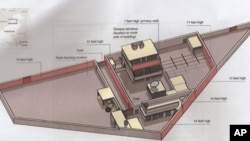The U.S. Special Forces operation that killed al-Qaida leader Osama bin Laden was the result of years of work to integrate intelligence and military capabilities, as well as painstaking investigation and analysis, much of it inspired by the 2001 terrorist attacks on the United States.
In the middle of the night, elite U.S. military commandos, perhaps accompanied by CIA operatives, descended from helicopters on a compound in a Pakistani city. U.S. officials say they fought their way from building to building, killing three men and a woman who was used as a human shield, before reaching the top floor of the compound’s main building. There, they found another woman and a man - the target of their operation - Osama bin Laden.
Officials say bin Laden resisted and was shot and killed by U.S. troops. The woman, who is believed to be one of his wives, was wounded. The troops then took bin Laden’s body, destroyed one of their helicopters, which had malfunctioned, and left. No U.S. troops and no civilians outside of the compound were injured, and the operation ended within 40 minutes, before Pakistani security forces could respond.
"It just makes you really impressed," said Michael O’Hanlon, an analyst at the Washington-based Brookings Institution. "Obviously, some of these problems we had a high level planning in previous decades have been corrected. We’ve learned the lessons at higher levels of command about how you prepare for these sorts of things."
O’Hanlon is referring to past U.S. operations that failed, including the effort to rescue U.S. hostages in Iran in 1980.
Intelligence expert Michael Swetnam of the Potomac Institute for Policy Studies says the U.S. government dedicated itself to developing a coordinated military and intelligence capability after the 2001 terrorist attacks on New York and Washington.
"The close training and operational relationship between the CIA and the special forces units in the military built an operational, covert, clandestine capability that could do what you saw happen over the last day. This really is the very best of the very best, the elite of the elite, if you will. And to pull something like this off really does take lots of practice, lots of training, and some of the very best that this country has to offer," he said.
Retired U.S. Army Lieutenant General James Dubik, who started his long career as a Special Forces officer and later rose to senior command positions, says the Special Forces provide more than raw military power to a commander. "First, [is] their incredible proficiency. Second, they bring to bear an incredible amount of intelligence analysis. This is fastidious, detailed, but very important work. And the third, they have an array of transportation and fire support assets that give them operational maneuverability over large, large areas under highly stealthful conditions," he said.
That is how the force managed to fly undetected, apparently about 150 kilometers from a base in Afghanistan to the Pakistani city of Abbottabad, north of Islamabad.
But the operation that sounds like a scene from a Hollywood movie would not have happened without the detailed and difficult job of analyzing vast amounts of information to find a few significant facts, and then to follow those leads and confirm them. That is the so-called "connect the dots" capability that experts said did not exist in 2001 when al-Qaida attacked the United States.
Officials say some of the information came from long-term detainees like those at the Guantanamo Bay, Cuba detention facility.
Again, Michael Swetnam of the Potomac Institute for Policy Studies. "This is a great example of how detainees, the people we’ve been questioning, have given us information that allowed us to be successful. And the value of what they’ve given us in information will go on for years and years and years to come," he said.
At the Brookings Institution, Michael O’Hanlon says those ongoing interrogations, along with other information and the analysis that follows, overcame bin Laden’s efforts to avoid detection by more high-technology means. "Bin Laden was very good at hiding and very good at going silent in terms of any and all electronic transmissions, once he realized just how capable we are of tracking those kinds of devices. And so to find him anyway, even if it took a decade, is really a quite notable accomplishment," he said.
Still, the experts agree that although the successful attack on Osama bin Laden is important, it is not the end of the U.S.-led war on al-Qaida and related groups. Experts note that terrorist cells have become more autonomous in recent years, and they say more detailed intelligence work, and perhaps more dramatic Special Forces raids, lie ahead.










